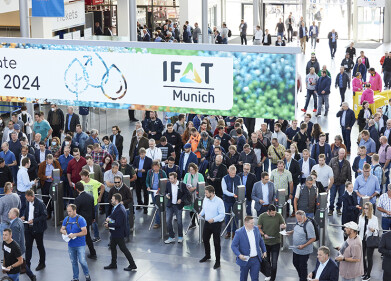Water/Wastewater
Environmental Overachievers Harvest Free Green Energy From Food Process Water
Mar 20 2017
A waste-to-energy project undertaken by the world’s largest integrated pineapple operation, Del Monte Philippines Inc. (DMPI), has exceeded even the high effluent quality targets originally set for the job.
The Global Water Engineering (GWE) wastewater treatment installation at the Cagayan de Oro pineapple canning plant has achieved 93 percent organic pollution (COD) removal in its anaerobic reactors, producing in the process enough green energy (methane rich biogas) to power two 1.4 MW generating electrical power generator units or gensets. The effluent of the anaerobic digestion step is further polished in an activated sludge type final treatment step to satisfy the local DENR discharge effluent standards.
DMPI – which accounts for about 10 per cent of the world’s annual production of processed pineapple products – will benefit from environmentally clean electricity to replace fossil fuels typically used in electrical power plants. And the waste heat from the gensets is also put to use to heat up steam boiler feed water, which is a further reduction of fossil fuel use in the factory. says GWE Chairman and CEO Mr Jean-Pierre Ombregt.
DMPI processes more than 700,000 tons of pineapple and papaya a year to produce more than 100 food and vegetable variants. DMPI is owned by Del Monte Pacific Ltd (DMPL), who also owns Del Monte Foods Inc., the company that owns the Del Monte brand in the USA. DMPI is one of the largest producers, distributors and marketers of premium quality, branded food products for the US retail market through its affiliate DMFI, as well as private label products.
Benefits of the company’s new wastewater and green energy plant mean that DMPI can replace fossil fuels with green energy, and given the high prices of electricity form the Grid and the sometimes erratic supply, the plant will achieve rapid ROI payback. Generally this takes only 2 to 5 years, says Mr Ombregt, whose company has installed more than 150 waste-to-green energy plants worldwide and ca. 400 high quality industrial wastewater and waste treatment plants, the benefits of which are applicable to any manufacturing operation with one or more organically loaded wastewater and waste streams.
“The DMPI plant has substantially exceeded even the high environmental goals set by the company for the treating more than 13,000 cubic metres a day of wastewater, or nearly five million cubic metres a year.”
“Process results are substantially better than the guaranteed levels of the project, with anaerobic effluent achieving ca. 40 mg/l COD (93 percent removal) and final effluent achieving 70 mg/l COD, or a further 83 percent removal.”
“This is remarkable in an operation so large and a compliment to the foresight of DMPI. In terms of the positive environmental impact and the virtually free electricity gains going straight to the bottom line, this is an exemplary project for food, beverage and agribusiness processors worldwide.”
Elements of the GWE process tailored to the needs of the DMPI include:
• Pre-treatment of flume wastewater for large solids and sand removal before joining with the rest of the effluents which pass a primary clarifier.
• Anaerobic digestion in four ANUBIX™ B (UASB type) methane reactors of a type proven globally for low-to-medium strength mainly soluble carbohydrate containing effluents, attaining outstanding COD removal efficiencies, in some cases even up to 99%
• Aerobic activated sludge type polishing treatment of the anaerobic reactor effluent (upgrade of existing facilities)
• Mechanical sludge dewatering of the aerobic excess sludge (by reuse of existing facilities)
• Biogas sweetening in a 2 step (physico-chemical followed by biological) SULFURIX™, BIOSULFURIX™ process for sulphur removal, followed by GASODRIX™ biogas drying
• Feed of the sweetened and dried biogas to the 2 electricity generation sets
GWE anaerobic technologies have been successfully deployed on diverse organic and agribusiness waste streams produced by industries including food and beverage processing, starch and fermentation industry, pulp & paper and many other type of agro-industry.
Their success was recognised by GWE’s successful entry in the 2014 IChemE award for the best project or process to demonstrate innovation in renewable energy, alternative energy sources, efficient energy use or the development of energy production methods that reduce energy and water intensity.
The winning entry involved pulp processing at the Chok Chai Starch cassava processing plant in Thailand. The Institution of Chemical Engineers (IChemE) is the global professional institution for chemical and process engineers with 40,000 members across 120 countries.
“Biogas from waste water is an outstanding source of base load power. As part of a renewable energy mix – complementing wind and solar generation, for example – electricity generated with biogas is highly reliable and consistent.”
“As the major component of natural gas, methane is an environmentally attractive alternative to fossil fuels,” said Mr Ombregt, whose company was complimented by DMPI on achieving better than guaranteed process results.
DMPI also complimented GWE on the quality of equipment supplied and workmanship in construction and installation, as well as professionalism of operational supervision. GWE was subsequently awarded a supervision contract extending until 2017 to optimise plant operation.
Events
Apr 22 2024 Hannover, Germany
Apr 23 2024 Kuala Lumpur, Malaysia
Apr 24 2024 Sao Paulo, Brasil
May 05 2024 Seville, Spain
May 13 2024 Munich, Germany














